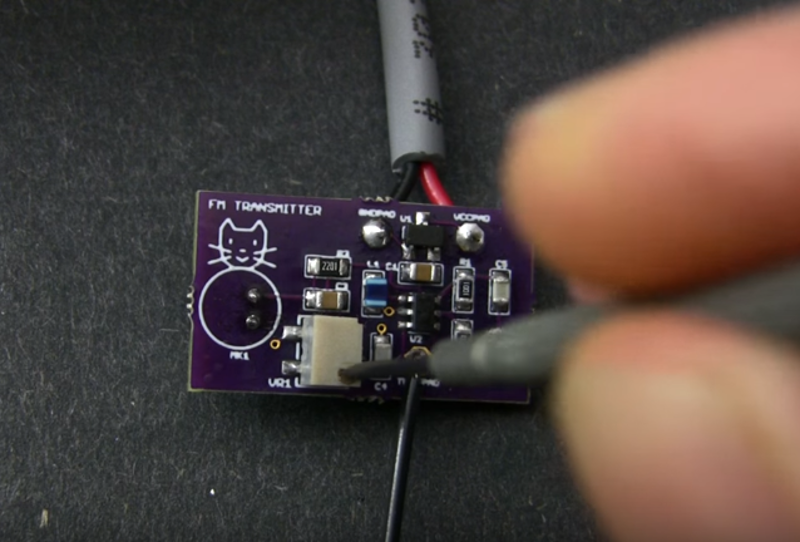One of our favorite purveyors of electronics knowledge is at it again. This time, [Afroman] explains how frequency modulation works while building up a short-range FM transmitter on a board he has available at OSH Park.
The design is based on a MAX2606 voltage-controlled oscillator (VCO) chip that can do 70-150MHz. [Afroman] sets it up to oscillate at about 100MHz using a 390nH inductor. He also put a potentiometer voltage divider on the 2606’s tuning pin. Voltage changes issued through the pot alter the transmitting frequency in small increments, making it easy to dial in a suitable channel for your broadcast. Add an electret mic and about a meter’s worth of solid-core wire and you have yourself an FM transmitter that is good for around 20 meters.
There are plenty of ways to build a small FM transmitter that allow for some experimentation and don’t involve placing SMD components. We covered a build last summer that uses a couple of 3904s and rides a 9V connector salvaged from a dead battery. The downside is that transistor-based transmitters tend to be less frequency-stable than a VCO chip.















The only Afroman I respect is the one who sang “She won’t let me f…” and “Because I got high”
Palmdale.
I was singing that song myself last night. And I know why!
Making an FM wireless mike from scratch with discrete components was a bit of a rite of passage back in the Sixties for budding electronic hobbyists. There was a certain level of satisfaction from hearing your own voice the first time carried by something you built with your own hands that few other projects gave one.
And a level of fury how crap the frequency stability is :x
This is a really cool project, and certainly a good one for anyone interested in learning electronics to try their hand at.
Anyone who has studied the history of amateur radio knows that decades ago homebrewing a transmitter was pretty much the only way anyone could actually get on the air. Now there are very few people scratch-building transmitters. This is a great way to get more people doing exactly that.
Well done, [Afroman].
I find the video tutorial format lacking for most electronics topics. It’s much harder to skim through a video than it is to skim over parts of written text. In a standard blog post, even if the schematics are not in pdf, I can right-click the png image and “save as”.
For a tutorial on how to drag solder smd parts, video is good, but for the math and schematics, stick to text.
Looks like the oscillator has plenty of harmonic distortion (or the scope is bad).
It does have a fair amount of distortion yes.
what’s the maximum distance that is legal without a license?
Distance is irrelevant. If you interfere with a device 2 cms from your transmitter it is illegal.
https://en.wikipedia.org/wiki/FM_transmitter_(personal_device)
It’s not distance, it’s power. Many countries made a small exception a few years ago when those MP3-to-FM transmitters came about. Typically a microwatt.
Wish I could find a picture, but I remember building a single transistor FM transmitter back in the day, complete with hand wound wire over a bolt inductor. Worked like crap, but it did work, that is, if you could figure out what frequency it was transmitting at.
I built several of those back in the day too. Always had the frequency stability problem so I wanted to show something a bit more reliable.
Ditto… with the added excitement of doing something that was quite illegal in my neck of the woods.
So I built some single and double transistor transmitters and pretty exited about it. I love the Tetsuo Kogawa design that was featured in Make magazine, can recommend it: http://makezine.com/projects/super-simple-fm-transmitter/
Anyway. I was less successful in building the side of the spectrum, a receiver. Does anyone has recommendations for a simple fm range receiver design?
Look up “Radio shack special fm receiver” on Google. You’ll find a low component count receiver circuit that should get you going. Haven’t built one myself but have been meaning to. Did build a Chrystal FM Radio a while back. It worked but needed an amplifier to listen because the signal was so weak.
My online nickname in high school was Afroman because I had a small afro and I think afros are cool. I named the site Afrotech in the vein of Anandtech and Bit-tech. As to how I have “gotten away with it”? Simple. Most normal people don’t have a mental association between the word “afro” and the N word like you do.